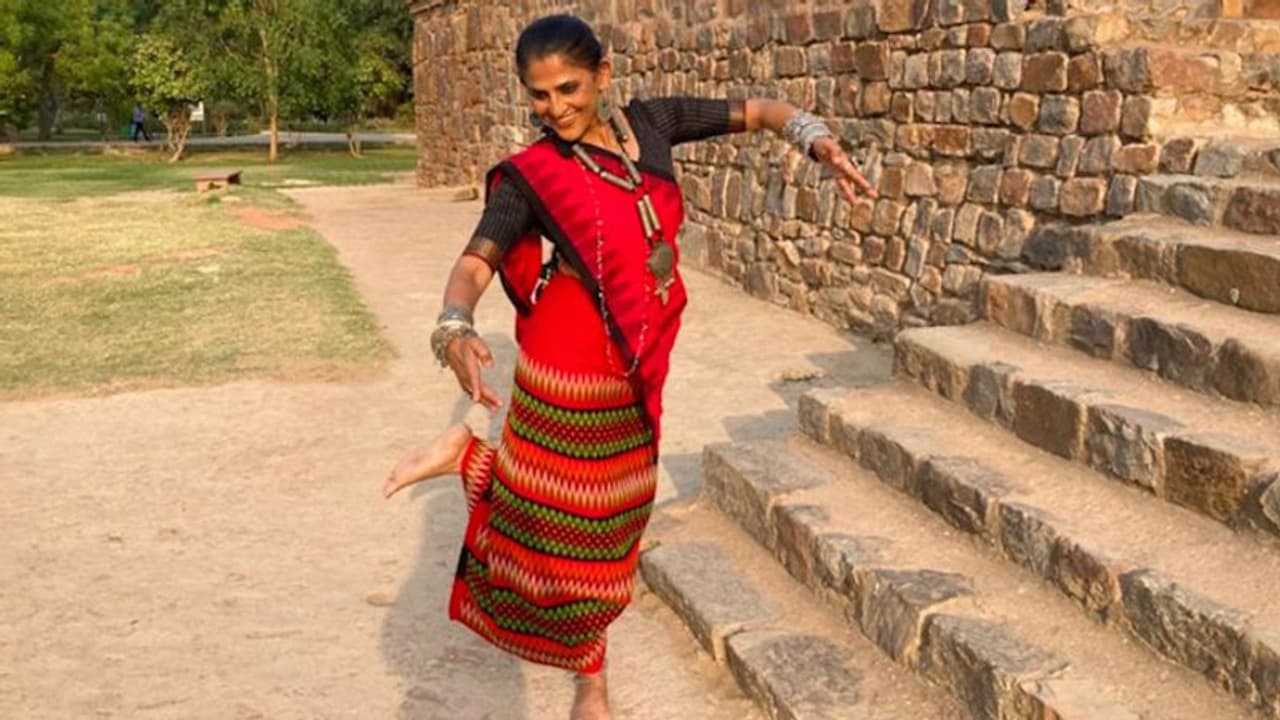Dr Navina Jafa, the well known Kathak dancer, scholar, and expert on cultural skills and heritage tourism.
The approaching International Dance Day 2023 took me into a world of a person who has redefined dance performance space and has stretched dance to add value to marginalised creative communities through heritage tourism. She is Dr Navina Jafa, the well-known Kathak dancer, scholar, and expert on cultural skills and heritage tourism.
The interaction with her translated into a heritage walk in the Lodi Gardens, which was about hearing the story of the tombs and seeing her dance the architecture of the arches. As she danced, she explained, "Do you know, in Indian performing arts, the rhythmic patterns are like brush strokes that describe all kinds of dynamic formations? For example, see this central polyfoil arch. The design replicates the rhythmic design called the Strotgata Yati, where the pattern begins at a spot and gradually expands." It was sheer wonder when she emerged from the arched gate of medieval stark Lodi tombs wearing a colourful wraparound from Arunachal Pradesh, North-East India, her dancing arms full of silver bangles; the Manipuri stole swayed around her body, and her plaited hair with hand-made tassels embellished with shells, bells and coins jingled. On her finger, she wore rings with a head of Cleopatra and around her neck, an imposing silver bead necklace from Zanskar, Ladakh. Jafa presented the epitome of a moving-talking and dancing living bioscope of 'India'. We walked and talked about her journey, interspersed with dance performances.
What is the idea behind 'performing heritage'?
NJ – The idea of 'performing heritage' evolved with my journey in Indian Culture when I began to learn and perform Kathak Dance. The world of dance allowed me to explore paintings, sculpture and literature. Kapila Vatsyayan, the doyen of Indian Culture, became my mentor at ten. Her eyes guided me to see the layers of Indian cultural expressions. Next, Pandit Birju Maharaj, my dance Guru since my teenage years, saw music, rhythms and movement in everyone. And then, my Fulbright Scholarship Advisor Richard Kurin at the Smithsonian Museum taught the art and science of curating, designing and displaying cultural heritage so that the viewer performs the poetry of the seen art form.
You often use the hashtag #dancebeyondstage; what does it imply, and can you provide examples?
NJ - The phrase implies questioning traditional limited performance spaces for Indian classical dance. The dancers need to go beyond prosceniums. That requires insightful academic training in cultural studies and imaginative application of dance as a language to interpret the cultural context. These days, dancers perform in a beautiful natural setting and upload popular music as reels and posts on social media. Nevertheless, #dancebeyondstage is about enhancing the understanding of the environment as the main objective of such reels. For example, when I present the site of the Kandariya Mahadev Temple of the world heritage site – Khajuraho, I dance to the sculpture of the Devangana – the celestial woman playing the flute. The process involves, first, understanding and communicating the iconographic importance of the idea of the Devangana representing the energy of the shakti for the pilgrim who is circumambulating or performing the pradikshina. The performance of the flute playing maiden must be powerful enough to impact the viewers participating in heritage tourism to hear the sound of the music and be engaged in the lines of the female dancing body that the sculpture intends to create.
You often say that dance is a language of development communication. Can you elaborate?
NJ - The Election Commission of India engaged my services in the General Indian election of 2019 as the vice president of Centre for New Perspectives, a not-for-profit organisation, to make local performing artists to motivate registered women voters to come and vote in three districts of Rajasthan. We took out a Bahurupiya Yatra covering 52 villages doing interactive performances with the Bahurupiya ( traditional impersonator ), street acrobats, and a young cross-dresser folk dancer. Before the performance, a colleague and I conducted a survey and learned that since no government addresses water problems, the women decided to boycott voting. To encourage the women, the folk dancer and I, on occasion, performed dances on fetching water which the audiences enjoyed together with the humorous dialogue of the bahurupiyas. The impact of the performances led to an increase of around 2.1% in the turnout of women voters in the respective districts.
What are your views on tourism and dance festivals in Heritage sites?
NJ - The annual dance festivals at different heritage sites are prestigious and popular, increasing tourist footfall. However, as a cultural technocrat working on sustainable development, market connectivity of creative skills and strategies, the perspective is narrow. First, these are one-time events requiring deeper thinking to provide sustainability on various levels. Every time a performance is choreographed as a solo or as a group, the performer needs to understand the archaeological site. The artist must highlight the heritage building's themes and other aspects of architecture and iconography.
You have the copyright on Academic tourism,' and many organisations have awarded you for heritage tourism. What, in your view, is the value addition you have done through dance?
NJ - I have been training guides and creating awareness among tourism agencies to engage dancers to accompany them on tours and heritage walks. India has so many cultural skills, especially that of crafts. In order to enhance the value of these fantastic heritage-skilled communities, I often use dance to amplify their creative genius. For example, when doing a heritage walk in the UNESCO craft village Raghurajpur in Odisha, I often perform impromptu as the patta chitra (cloth scroll painter) sings the scene in the scroll he displays. Similarly, while curating a heritage walk in the workshop of Padma Vibhushan sculptor Sudarshan Sahoo, I perform to bring the sculptures alive as the master recited.
Disclaimer: This is a featured content
